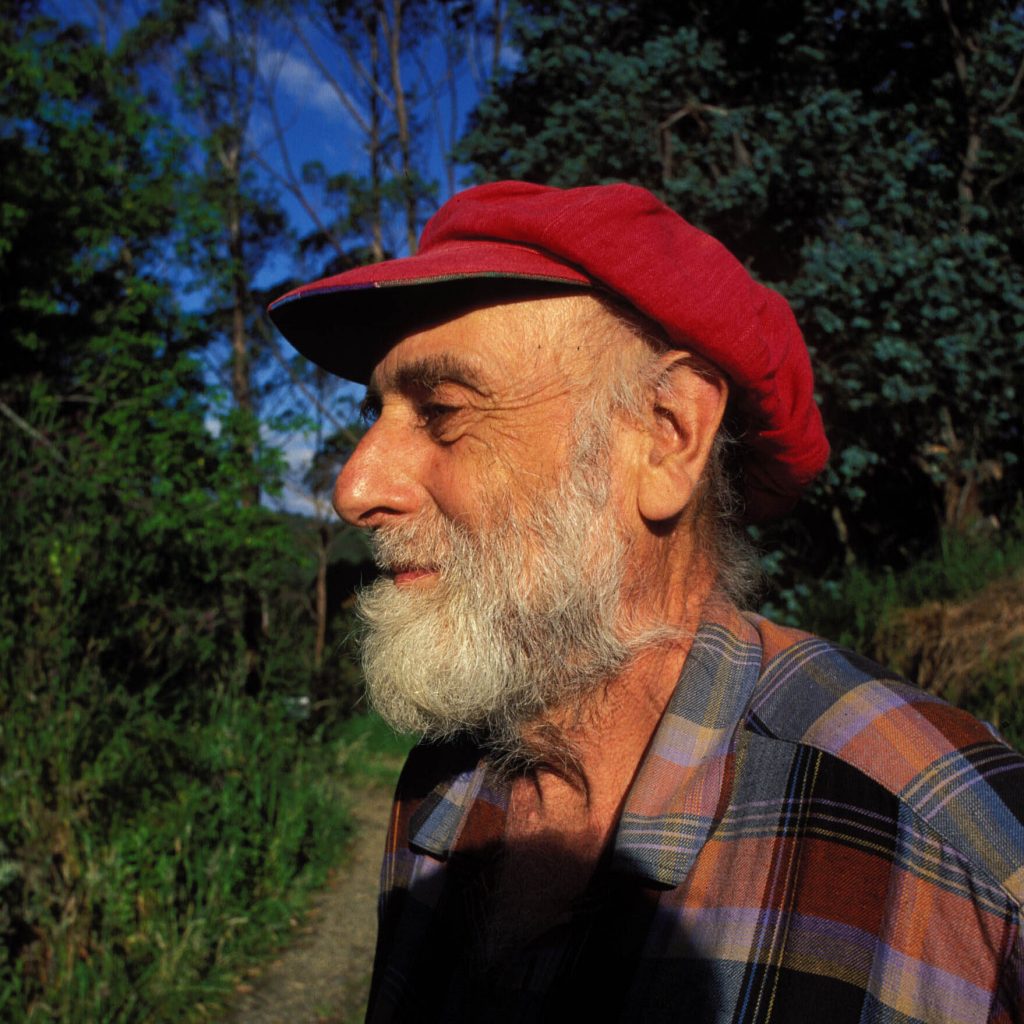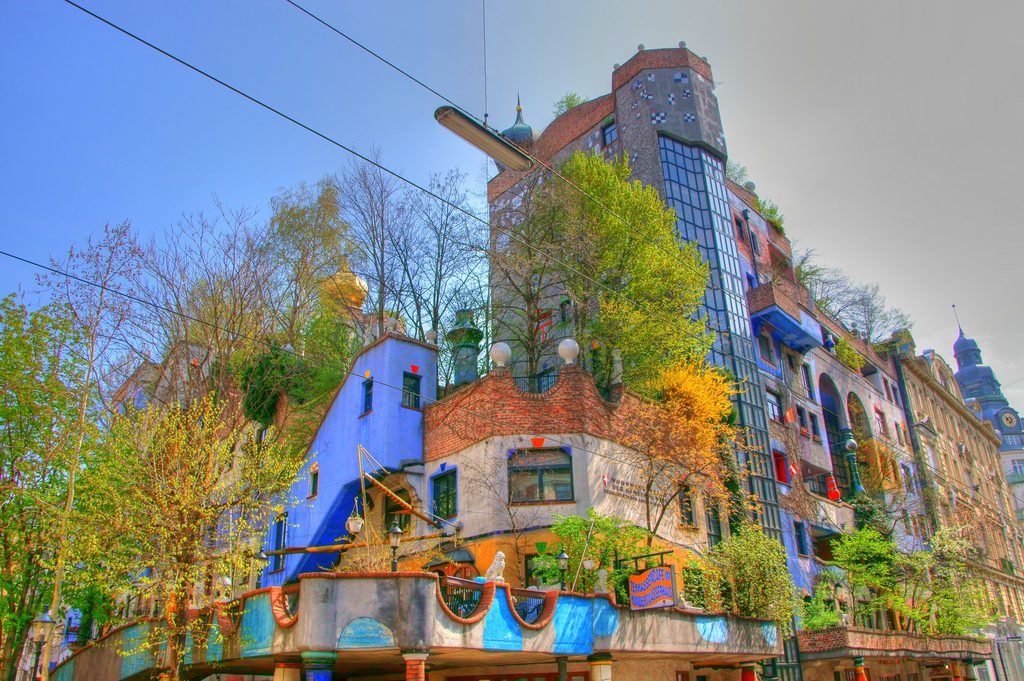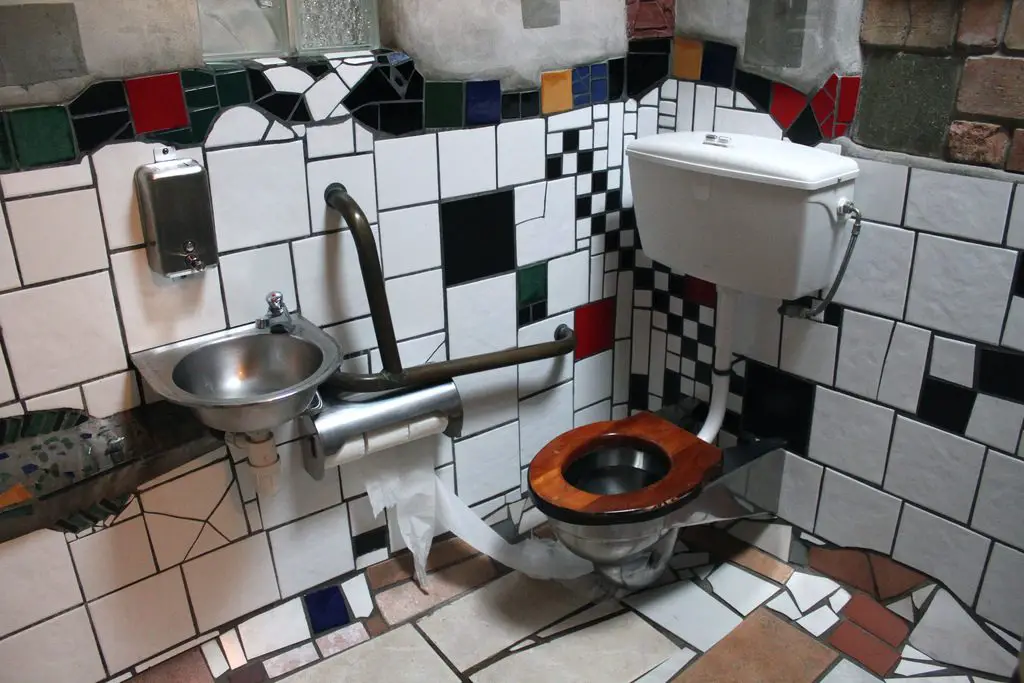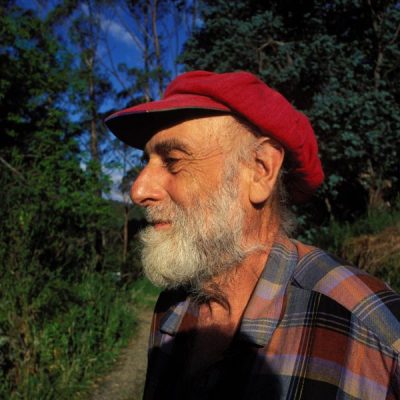Hundertwasser was a visionary artist who promoted a life that is in harmony with nature through his art. His accomplishments in the world of art and architecture are worth studying. Our kids need to study his art which will help them in leading a life that completes nature rather than destroying it. We have gathered a complete set of “Hundertwasser Facts” which will provide a brief overview of Hundertwasser, his life, and most importantly his work. This is the best information source about Hundertwasser For Kids and Hundertwasser Biography.
Hundertwasser Facts – Hundertwasser For Kids
1. Who Is Friedensreich Hundertwasser
- Friedensreich Regentag Dunkelbunt Hundertwasser (Friedrich Stowasser) was an artist and an architect.
- He was born in Austria, but also had the nationality of New Zealand where he spent his later life.
- Besides his work in the field of art and architecture, he is also well-known as an environmentalist and eco-activist.

2. What Did Hundertwasser Do
- Hundertwasser traveled, resided, and worked in various places all around Europe, Australia, North Africa, New Zealand, and Eastern countries.
- Apart from his spiritual and visionary artistic activities, he also raised his voice for certain general issues like the preservation of marshlands in Hainburg (Austria) and protested against Austrian accession to the European Union.
- He was a great opponent of nuclear power plants, as they create certain environmental issues and their radioactive wastes are capable of affecting human health for centuries.
- In New Zealand, he planted more than 150,000 trees in his valley with the help of construction companies and farmers.
- Through his art, he tried to reveal the possibilities of a better world with a safe environment and protected nature.
- Whatever he spoke out for, he endorsed autonomously and authentically.
3. What Does Hundertwasser Mean
- “Hundert” means hundred and “Wasser” means water, so collectively “Hundertwasser” means hundred-water, both are German words.
- Hundertwasser assumed this name in 1949 from his original name “Stowasser” in which “Hundert” is the German translation of the Slavic word “sto” which means “(one)hundred”
- “Friedensreich” is a double-meaning word, which means “peace-kingdom” and “peace-rich”. He chose this name for himself in 1969.
- So, the direct translation of the name “Friedensreich Hundertwasser” in English is “Peace-Kingdom Hundred-Water”.
- He also selected other names for himself like “Regentag”, which means “Rainy-day” and “Dunkelbunt”, which means “Darkly multi-colored”.
4. What Was Hundertwasser’s Real Name
- The real name of Friedensreich Hundertwasser was “Friedrich Stowasser”.
5. Why Did Hundertwasser Changed His Name
- Friedensreich Hundertwasser studied the Russian language in 1949 in which he learned that the German translation of the word “sto” in his last name was ‘hundert’ (hundred). So he changed his last name from “Stowasser” to “Hundertwasser”.
- In 1961, Friedensreich Hundertwasser found out that the word “reich” in the German language has double meanings that are “kingdom/realm” and “rich”, so he changed his first name from ‘Friedrich’ to ‘Friedensreich’.
- Hundertwasser added “Regentag” (rainy day) to his first name because he loved the bright colors display by nature when it rained.
- He also added the word “Dunkelbunt” (Darkly multi-colored) to his first name because strong and dark colors were his favorite.
6. Where Was Hundertwasser Born
- Hundertwasser was born on December 15, 1928, in Vienna (Austria).
7. Where Did Hundertwasser Lived
- Hundertwasser spent his life’s initial 20 years in Vienna (Austria) where he got his education.
- In 1949, he started traveling and went to Northern Italy, Rome, Naples, Sicily, and Tuscany, where in Florence he met Rene Bro and traveled after him to Paris.
- In 1951, he spent the winter and spring in Morocco and Tunisia from where he went back to Paris.
- He lived in Japan for one year in 1961, where he received the Mainichi Prize at the event of the 6th International Art Exhibition.
- He traveled throughout his life and worked in different countries like Australia, Africa, New Zealand, Europe, and Eastern countries.
- He lived in New Zealand in his later life till his death.
8. What Is Hundertwasser Famous For
- Hundertwasser is famous for his unique and visionary paintings, art, and architecture that reflect his philosophy of a compatible interaction between human beings and nature.
- He is well-known for being an autonomous and independent artist, and for the lack of affiliation of his ideas with any “ism”.
- He is also very famous for his efforts in the field of environmental protection.
9. Where And How Did Hundertwasser Die
- Hundertwasser died on February 19, 2000, at the age of 71.
- He died from a congestive heart attack while traveling from his adopted New Zealand home to Europe on the cruise ship of Queen Elizabeth II, in the Pacific Ocean.
- He was buried in the Garden of the Happy Dead in New Zealand according to his wish.
10. When Did Hundertwasser Become An Artist
- The artistic abilities of Friedensreich Hundertwasser appeared at an early age.
- In 1948 after World War II, he joined the Academy of Fine Arts in Vienna for three months, and that was the time when he started signing his art as Hundertwasser rather than Stowasser.
- In 1952, the exhibition of his first paintings was held in Vienna and that is considered as his first commercial success in painting.
11. What Was Hundertwasser Inspired By
- Hundertwasser was an independent, autonomous, and unique artist.
- He didn’t permit himself to scheme and plan his works, as he believed that it might decrease their naturalness and spontaneity. This was his inspiration process and he called it a “Vegetative” process.
- However, due to the use of biomorphic forms and tiles, his architectural work shows similarities with Spanish architect Antoni Gaudi (1852-1926).
- Hundertwasser was inspired by the Austrian painters Gustav Klimt (1862-1918) and Egon Schiele (1918), and by the artwork of Vienna Secession.
12. Hundertwasser Philosophy
- According to Hundertwasser “There are no evils in nature. There are only evils of man.”.
- Hundertwasser believed in the philosophy of aesthetics, that is the harmony of life and art with nature.
- He was an opponent of the straight lines in building design, which according to him break the correlation between mankind and nature.
- In his architecture philosophy, columns do not have only a supportive function, they also seem like trees growing out of the earth.
- Hundertwasser introduced the grass roofs, which according to him embody the essential characteristics of natural hygiene.
- Hundertwasser always focused on the experience and fantasy of the viewers, and on this basis, he founded a painting style – “transautomatism”.
- He endeavored to offer a glimpse of paradise to the viewers, and for this purpose, he used distinct, strong, and dark colors in his work. According to him “Paradise is not made of a random compilation of colors but distinct creative colors”.
13. Hundertwasser Art Style – Hundertwasser Art Facts
- The art style of Friedensreich Hundertwasser was individualistic, autonomous, and unique.
- He was an independent artist and was never affiliated with any “ism” or school of thought or philosophy in painting.
- He was a visionary artist who rejected all standardizations, traditional rules, artistic philosophies, and techniques in his work.
- He never had any studio and created his masterpieces without an easel or conventional canvases, instead, he used to spread canvas or paper flat in front of himself.
- His work seems like the work of children, as he believed that children have special creative processes free of any custom and tradition as true and real expressions. He gave name to this creative and unique process as “transautomatism”.
- His original and unique artistic vision conveys philosophy and environmentalism that is obvious from his paintings, postage stamps, flags, and the design of facades in pictorial art.
- In his work, he rejected straight lines and was fascinated by spirals, as he noticed that there are no straight lines in nature.
- He commonly used organic forms and bright colors in his work.
- The major theme of all of his works is “reconciliation and harmony of mankind with nature”.
14. Hundertwasser Art – Hundertwasser Artwork
- The best and most well-known work of Hundertwasser is the Hundertwasserhaus in Vienna (Austria).
- His other works include:
- A church in Barnbach (Austria).
- A district heating plant and KunstHausWien (museum) in Vienna.
- Housing complexes and Kuchlbauer Tower in Germany.
- A railway station in Uelzen (Germany).
- A sludge center and incineration plant in Osaka (Japan).
- A winery in Napa Valley (California).
- The Hundertwasser toilet in Kawakawa (New Zealand).
- He created numerous paintings and 26 stamps for different postal administrations out of which 17 designs were executed as a postage stamp.
15. Hundertwasser Paintings
- The visionary paintings of Hundertwasser have fantasy and uniqueness.
- In painting, he experimented with various techniques and invented new ones.
- He used many paints in one painting and often made his paints himself.
- For painting, he used various types of papers and also some other materials, for example, his work 904 Pellestrina Wood is on the pieces of plywood, and 816 Switch Board is on a switchboard.
Hundertwasser Paintings Names – Hundertwasser Most Famous Paintings
- The most famous paintings of Friedensreich Hundertwasser are:
- 104 Cathedral I (1951)
- 224 The Big Way (1955)
- 433 The I Still Do Not Know (1960)
- 155 Three High Houses (1953)
- 690 Green Power (1972)
- 460 Hommage au Tachisme (1961)
- 775 Park (1978)
- 607 Girl-Finding in the Grass (1964)
- 221 Arabian Woman (1955)
- 532 The Lion of Venice (1962)
- 211 Moroccan Jews (1954)
- 531 Jew’s House in Austria (1962)
- 150 Singing Steamer in Ultramarine III (1959)
- 421 The Tower of Babel Pierces the Sun (1959)
- 583 Two Envelopes on a Long Voyage (1964)
- 398 The Mosque (1959)
- 816 Switch Board (1980)
- 738 Grass For Those Who Cry (1975)
- 745 Blobs Grow in Beloved Gardens (1975)
- 970 Who Has Eaten All My Windows (1996)
- 622 Mourning Schiele (1965)
- 557 Houses in the Snow in a Silver Shower (1962)
- 848A Homo Humus Humanitas (1986)
- 992 City Views (1994)
- 691A Irinaland Over the Balkans (1971)
- 686 Good Morning City (1970)
- 928 Antipode King (1991)
- 994 The Four Antipodes (1999)
- 498 The Beard Is the Grass of the Bald Head Man (1961)
- 728 Meadowman (1974)
- 814 Pavilions and Bungalows for Natives and Foreigners (1980)
- 825 The Trees Are the Flowers of the Good (1982)
- 846A Window Right (1986)
- 700 Olympic Games Munich 1972 (1971)
- 839 The Third Skin (1982)
- 781 Green Town (1978)
- 626 The Way to You (1966)
- 553A Street for Survivors (1971)
- 697A Regentag on Waves of Love (1971)
- 551A Spiralsun and Moonhouse _ The Neighbours (1967)
- 603A Sunset (1966)
- 699A The Houses Are Hanging Underneath the Meadows (1972)
- 637A Waiting Houses (1969)
- 652 Journey II and Travel by Rail (1967)
- 850A The Second Skin (1986)
16. Hundertwasser Irinaland Over The Balkans
- Irinaland over the Balkans is one of the most enduring and strongest creations of Friedensreich Hundertwasser.
- He created this painting in 1969 in Rome and used 31 different colors on a silkscreen.
- Hundertwasser was close to Irina Maleeva, the Bulgaria actress whose face he painted in this painting.
- In painting, the scenery and patterns are created by using a large number of lines in different colors.
- The painting is a very exceptional portrait, as the portraits are generally assumed to represent people in their natural backgrounds, while in this painting a woman’s face is amalgamated into a housing association.

17. Hundertwasser Prints
- Friedensreich Hundertwasser created many prints of particular themes. Most of them were to raise awareness about environmental protection.
- Some of them are:
- “Save the Whales (+ Save the Seas)” (1982)
- 656 The Explosion (1968)
- Waiting Houses (from Nana Hyaku Mizu), (1969)
- 715 Homage to Schroder-Sonnenstern (1972)
- Crusade of the Crossroads (1972)
- Houses in Rain of Blood Hauser im Blutregen (1961)
18. Hundertwasser Cloths
- Friedensreich Hundertwasser rejected conformism and postulated that each person has individual and unique creativity.
- According to Hundertwasser, clothes are like the second skin of individuals and they must have unique and creative designs. That’s why he was an opponent of finished-part and prefabricated products.
- He started sewing his shirts and trousers in 1949, in which he utilized pieces of different clothes and also began to make his shoes.
- Since that time, he used clothes, pullovers, and socks sewn and knit after his design, and also his own designed winter and summer shoes and sandals.
- He was the forerunner of the “Creative Clothing Movement”.
- After the thinning out of his hair, he designed a cap made of colored materials which later became one of his trademarks.
- Wearing two dissimilar socks was a characteristic of Hundertwasser’s dressing.
- Thoughts of Hundertwasser on “The Second Skin” were published for the first time when he designed a suit for the November 1982 publication of Vogue magazine, Paris.
19. Friedensreich Hundertwasser Architecture
- Hundertwasser began work as an architect along with painting at the age of 55.
- Hundertwasser used decorations, bright colors, uneven lines, and endured to be in harmony with nature, so his architecture differs from the philosophies of rationalism and functionalism that were typically used in architecture during the 20th century.
- Hundertwasser had also a reputation as “the doctor of architecture” due to his belief that not all buildings are healthy and he treated the buildings in such a manner that decreased the environment’s visual pollution.
- Rogner Bad Blumau is a hotel complex in Austria, which is Hundertwasser’s greatest architectural project completed in 1997.




List Of Hundertwasser Buildings
| S.No | Building Name | Starting Year – Completion Year | Country |
| 1 | Mierka Getreidesilo | 1982 – 1983 | Austria |
| 2 | Hundertwasserhaus | 1983 – 1985 | Austria |
| 3 | Rupertinum | 1980 – 1985 | Austria |
| 4 | Hundertwasser village (Kalke village) | 1990 – 1991 | Austria |
| 5 | Textilfabrik Rueff und Hausnummern | 1982 – 1988 | Austria |
| 6 | Krankenstation (Onkologie) {Oncological department of the university hospital} | 1991 – 1994 | Austria |
| 7 | District Heating Plant, Spittelau | 1988 – 1982 | Austria |
| 8 | St,-Barbara Church, Barnbach | 1984 – 1988 | Austria |
| 9 | Dorfmuseum Roiten (Village museum in Roiten) | 1987 – 1988 | Austria |
| 10 | KunstHausWien | 1989 – 1991 | Austria |
| 11 | Autobahnrasthaus Bad Fischau (Motorway restaurant Bad Fischau) | 1989 – 1990 | Austria |
| 12 | Brunnenanlage Zwettl (Fountain at Zwettl) | 1992 – 1994 | Austria |
| 13 | Thermendorf Blumau (Hot Springs Village Bad Blumau) | 1993 – 1997 | Austria |
| 14 | Spiral Fluss Trinkbrunnen I (Spiral Fountain I) | 1994 – 1994 | Austria |
| 15 | Rosenthal Factory | 1980 – 1982 | Germany |
| 16 | Waldspirale | 1998 – 2000 | Germany |
| 17 | Hundertwasser Kindergarten | 1988 – 1995 | Germany |
| 18 | Die Grüne Zitadelle von Magdeburg | 2004 – 2005 | Germany |
| 19 | Kuchlbauer Tower | 2007 – 2010 | Germany |
| 20 | Luther-Melanchthon-Gymnasium | 1997 – 1999 | Germany |
| 21 | Wohnen unterm Regenturm | 1991 – 1994 | Germany |
| 22 | Wohnen in den Wiesen Bad Soden | 1990 – 1993 | Germany |
| 23 | Uelzen Station | 1999 – 2000 | Germany |
| 24 | de: Ronald McDonald Haus | 2004 – 2005 | Germany |
| 25 | Countdown 21st Century Monoment for TBM | 1992 – 1992 | Japan |
| 26 | Kids Plaza Osaka | 1996 – 1997 | Japan |
| 27 | Maishima Incineration Plant | 1997 – 2001 | Japan |
| 28 | Maishima Sludge Center | 2000 – 2004 | Japan |
| 29 | Quixote Winery | 1992 – 1999 | United States |
| 30 | Markthalle Altenrhein (Market at Altenrhein) | 1998 – 2001 | Switzerland |
| 31 | Hundertwasser toilet | 1999 – 1999 | New Zealand |
| 32 | Playa de Mogan “El Nido” | 1991 | Spain |
| 33 | Spiral Fluss Trinkbrunnen II (Spiral Fountain II) | 1996 – 1996 | Israel |
| 34 | Ronald McDonald Kindervallei | 2005 – 2007 | Netherlands |
20. Hundertwasser Stamps
- According to Hundertwasser, stamps have an important role in the representation of a country’s landscape, culture, and individuality.
- He invented 26 designs of stamps for various countries and organizations like Luxembourg, Senegal, Liechtenstein, and the United Nations.
- 17 out of his 26 designs were executed as postage stamps.
- All of his stamps were carved by the Austrian State Printing Office and by Wolfgang Schield, except the Cuban stamp and the service marks for the Council of Europe.
21. Hundertwasser Toilets – Hundertwasser Public Toilets New Zealand
- Hundertwasser toilets is a public toilet in Kawakawa (New Zealand) devised by Friedensreich Hundertwasser.
- Its construction was completed in 1999 and was also opened for use in that year.
- The toilet is a main tourist attraction of Kawakawa and is considered an international work of art.
- The toilet was constructed from recycled materials that included bricks from a former branch of the Bank of New Zealand and the spent glass bottles in the community.
- The building has typical Hundertwasser style like uneven lines and floors, colored glass, and olive trees.
- Functionally, it is like ordinary public toilets having separate areas for men and women.
- An interesting fact about the Hundertwasser toilet is that the tourists are often far more in number than the users.

22. Hundertwasser House Austria – Hundertwasserhaus In Vienna Austria
- Hundertwasser house or Hundertwasserhaus is an apartment house built from 1983 to 1985 in Vienna, Austria according to the concept and plan of Friedensreich Hundertwasser with Joseph Krawina, an architect who worked as a co-author in this project.
- Hundertwasserhaus is a part of the cultural heritage of Austria and is one of the most visited places in Vienna.
- It is characterized by uneven floors, vegetative roofs, large growing trees inside the rooms with extending branches from the windows.
- The house is composed of 53 apartments, 4 offices, 3 joint and 16 private terraces, and a whole of 250 bushes and trees.
23. Hundertwasser Museum Vienna
- KunstHausWien is a museum in Vienna (Austria) created by Friedensreich Hundertwasser.
- The building of the museum was designed to renovate the Thonet furniture factory (the inventor of the iconic bistro chair), a building that was built in 1892.
- The renovation process was sponsored by BAWAG P.S.K and was executed from 1989-1991 while Hundertwasser himself did its planning.
- The museum has a total of 4,000 square meters area of exhibition and was opened in April 1991.
- KunstHausWien is the only permanent exhibition of the works of Friedensreich Hundertwasser in the world, for which the two lower floors of the building are allocated.
- The museum also hosts temporary international exhibitions of other artists that are held on the third and fourth floors of the building.
- The building design is entire of the typical unique Hundertwasser art style, with uneven and irregular floors, bright colors, and a large amount of vegetation.
- There is a fountain in the entrance hall and there is also a restaurant with plentiful vegetation that is similar to a winter garden.
24. Hundertwasser Trees – Hundertwasser Lollipop Trees
- Hundertwasser draws trees in his paintings that look like lollipops due to their colorfulness and structure, so they are known as Hundertwasser lollipop trees.
- In the paintings of Hundertwasser, lollipop trees and buildings are shown in the association that reveals the message of harmony between nature and man.
- Hundertwasser planted about 150.000 trees in New Zealand.
- Trees and vegetation are a vital part of his designed buildings and other architectural works, as according to him trees are very necessary for a healthy environment.
25. Interesting Facts About Hundertwasser
- Hundertwasser was born in December 1928.
- His mother Elsa was Jewish while his father was a Catholic Christian, who died one year later of his birth.
- In 1935, Hundertwasser was baptized to avoid persecution and also joined the Hitler Youth corps in 1941.
- As his maternal relatives were Jews, more than 60 of them were killed in the Nazi concentration camps.
- Hundertwasser and his mother lived in the Viennese cellar during the Russian occupation and war. Hundertwasser married twice, first in 1958 with Herta Leitner that ended on divorce after two years, and second in 1962 with Yuko Ikewada, a Japanese artist who divorced him in 1966.
- Hundertwasser acquired properties of about 372 hectares in the Bay of Islands (New Zealand) in 1970, where he designed and experimented with a lot of his works including his first grass roofs.
- Hundertwasser strongly opposed nuclear power plants and in this context, he visited Washington D.C in 1980 to support the efforts of activist Ralph Nader.
- Hundertwasser has a daughter named Heidi Trimmel, his only child born in 1982.
26. Hundertwasser Quotes
- Some famous quotes of Friedensreich Hundertwasser are:
- “The straight line leads to the downfall of humanity.”
- “When we dream alone it is only a dream, but when many dream together it is the beginning of a new reality.”
- “A person in a rented apartment must be able to lean out of his window and scrape off the masonry within arm’s reach. And he must be allowed to take a long brush and paint everything outside within arm’s reach. So that it will be visible from afar to everyone in the street that someone lives there who is different from the imprisoned, enslaved, standardized man who lives next door.”
- “There are no evils in Nature, there are only evils of Man.”
- “I am looking forward to becoming humus myself buried naked without coffin under a beech tree planted by myself on my land in ao tea roa”.

